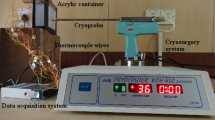Abstract
This study proposes a novel approach that utilises low thermal conductivity emulsions of perfluorodecalin as insulation around the tumour interface. The study reports the preparation of low thermal conductivity perfluorodecalin (PFD) emulsions (30%, 50%, 70% and 90% (w/v)) using probe sonication. The determination of thermal conductivity of these emulsions experimentally reveals a decrease in magnitude with the increase in the concentration of perfluorodecalin. The dynamic light scattering (DLS) and zeta potential studies indicate monodisperse and stable emulsions. Fourier transform infrared spectroscopy (FTIR) analysis confirms the presence of perfluorocarbon phase in the emulsion. The results of differential scanning calorimetry and theoretical estimation of thermal conductivity demonstrate that the increase of perfluorodecalin concentration lowers the specific heat and thermal conductivity of the emulsions. Experimental studies have been performed during cryosurgical freezing on an agarose gel phantom in the presence of a low thermal conductivity emulsion layer. The results suggest that in the presence of PFD 90 emulsion layer around the gel phantom the temperature at the 10 mm axial thermocouple the temperature is found to be 11 ∘C, whilst in the absence of this emulsion layer, the temperature is − 4 ∘C at the same thermocouple location, suggesting the insulating ability of perfluorocarbon emulsion layer. In conclusion, this study proposes a new approach that utilises low thermal conductivity emulsions for enhancing the cryosurgical freezing and minimising the damage to a defined region.










Similar content being viewed by others
References
Rubinsky B (2000) Cryosurgery. Annu Rev Biomed Eng 02:157–187
Mazur P (1970) Cryobiology: the freezing of biological systems. Science 168(3934):939–949
Orpwood RD (1981) Biophysical and engineering aspects of cryosurgery. Phys Med Biol 26(4):555–575
Gage A, Caruana J, Montes M (1982) Critical temperature for skin necrosis in experimental cryosurgery. Cryobiology 19(3):273–282
Neel H, Ketcham A, Hammond W (1971) Requisites for successful cryogenic surgery of cancer. Arch Surg 102:45–48
Yonggang L, Zou Y, Yang L (2011) Feasibility study for thermal protection by microencapsulated phase change micro/ nanoparticles during cryosurgery. Chem Eng Sci 66(17):3941–3953
Ramajayam KK, Kumar A (2013) A novel approach to improve the efficacy of tumour ablation during cryosurgery. Cryobiology 67(2):201–213
Freire MG, Dias AMA, Coelho MAZ, Coutinho JAP, Marrucho IM (2005) Aging mechanisms of perfluorocarbon emulsions using image analysis. J Colloid Interface Sci 286(1):224–232
Wagner C (1961) Theorie der Alterung von Niderschlagen durch Umlösen (Ostwald Reifung). Z Elektrochem 65:581–591
Van den Tempel (1953) Stability of oil-in-water emulsions II: Mechanism of the coagulation of an emulsion. Recueil des Travaux Chimiques des Pays-Bas 72(5):433–441
Barnett BP, Ruiz-Cabello J, Hota P, Ouwerkerke R, Shamblott MJ, Lauzon C, Walczak P, Gilsona W D, Chacko VP, Kraitchman DL, Arepally A, Bulte JWM (2011) Use of perfluorocarbon nanoparticles for non-invasive multimodal cell tracking of human pancreatic islets. Contrast Media Mol Imaging 6(4):251–259
Lee HY, McCarthy MJ, Dungana SR (1998) Experimental characterization of emulsion formation and coalescence by nuclear magnetic resonance restricted diffusion techniques. JAOCS 75(4):463–475
Riddick T (1968) Control of Colloid Stability through Zeta Potential with a closing chapter to cardiovascular disease. Livingston Publishing Company, Pennsylvania
Maxwell JC (1958) A treatise on electricity and magnetism. Dover, New York
Cheng SC, Vachon RL (1970) A technique for predicting the thermal conductivity of suspensions, emulsions and porous materials. Int J Heat Mass Transf 13(3):537–546
O’Neill MJ (1966) Measurement of specific heat functions by differential scanning calorimetry. Anal Chem 38 (10):1331– 1335
Al-Shamrani AA, James A, Xiao H (2002) Destabilisation of oil-water emulsions and separation by dissolved air flotation. Water Res 36(6):1503–1512
Marinova KG, Alargova RG, Denkov ND, Velev OD, Petsev DN, Ivanov IB, Borwankar RP (1996) Charging of oil-water interfaces due to spontaneous adsorption of hydroxyl ions. Langmuir 12(8):2045–2051
Acknowledgements
The authors would like to thank Department of Biotechnology and Medical Engineering, NIT Rourkela and Department of Mechanical Engineering, NIT Rourkela for the financial support. A special note of appreciation to Dr. S.K. Pratihar, Department of Ceramic Engineering, NIT Rourkela and Mr Arvind, Technical Staff, Department of Ceramic Engineering, NIT Rourkela for providing the slots of dynamic light scattering analysis regularly.
Author information
Authors and Affiliations
Corresponding author
Ethics declarations
Conflict of interest
The authors would like to declare that there is no conflict of interest.
Additional information
Publisher’s Note
Springer Nature remains neutral with regard to jurisdictional claims in published maps and institutional affiliations.
Rights and permissions
About this article
Cite this article
Ramajayam, K.K., Kumar, A., Sarangi, S.K. et al. A study on improving the outcome of cryosurgery using low thermal conductivity emulsions. Heat Mass Transfer 54, 3727–3738 (2018). https://doi.org/10.1007/s00231-018-2397-0
Received:
Accepted:
Published:
Issue Date:
DOI: https://doi.org/10.1007/s00231-018-2397-0




